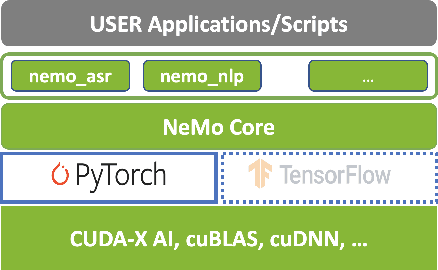Samuel Kriman
Nemotron-H: A Family of Accurate and Efficient Hybrid Mamba-Transformer Models
Apr 10, 2025Abstract:As inference-time scaling becomes critical for enhanced reasoning capabilities, it is increasingly becoming important to build models that are efficient to infer. We introduce Nemotron-H, a family of 8B and 56B/47B hybrid Mamba-Transformer models designed to reduce inference cost for a given accuracy level. To achieve this goal, we replace the majority of self-attention layers in the common Transformer model architecture with Mamba layers that perform constant computation and require constant memory per generated token. We show that Nemotron-H models offer either better or on-par accuracy compared to other similarly-sized state-of-the-art open-sourced Transformer models (e.g., Qwen-2.5-7B/72B and Llama-3.1-8B/70B), while being up to 3$\times$ faster at inference. To further increase inference speed and reduce the memory required at inference time, we created Nemotron-H-47B-Base from the 56B model using a new compression via pruning and distillation technique called MiniPuzzle. Nemotron-H-47B-Base achieves similar accuracy to the 56B model, but is 20% faster to infer. In addition, we introduce an FP8-based training recipe and show that it can achieve on par results with BF16-based training. This recipe is used to train the 56B model. All Nemotron-H models will be released, with support in Hugging Face, NeMo, and Megatron-LM.
RULER: What's the Real Context Size of Your Long-Context Language Models?
Apr 11, 2024Abstract:The needle-in-a-haystack (NIAH) test, which examines the ability to retrieve a piece of information (the "needle") from long distractor texts (the "haystack"), has been widely adopted to evaluate long-context language models (LMs). However, this simple retrieval-based test is indicative of only a superficial form of long-context understanding. To provide a more comprehensive evaluation of long-context LMs, we create a new synthetic benchmark RULER with flexible configurations for customized sequence length and task complexity. RULER expands upon the vanilla NIAH test to encompass variations with diverse types and quantities of needles. Moreover, RULER introduces new task categories multi-hop tracing and aggregation to test behaviors beyond searching from context. We evaluate ten long-context LMs with 13 representative tasks in RULER. Despite achieving nearly perfect accuracy in the vanilla NIAH test, all models exhibit large performance drops as the context length increases. While these models all claim context sizes of 32K tokens or greater, only four models (GPT-4, Command-R, Yi-34B, and Mixtral) can maintain satisfactory performance at the length of 32K. Our analysis of Yi-34B, which supports context length of 200K, reveals large room for improvement as we increase input length and task complexity. We open source RULER to spur comprehensive evaluation of long-context LMs.
Investigating End-to-End ASR Architectures for Long Form Audio Transcription
Sep 20, 2023Abstract:This paper presents an overview and evaluation of some of the end-to-end ASR models on long-form audios. We study three categories of Automatic Speech Recognition(ASR) models based on their core architecture: (1) convolutional, (2) convolutional with squeeze-and-excitation and (3) convolutional models with attention. We selected one ASR model from each category and evaluated Word Error Rate, maximum audio length and real-time factor for each model on a variety of long audio benchmarks: Earnings-21 and 22, CORAAL, and TED-LIUM3. The model from the category of self-attention with local attention and global token has the best accuracy comparing to other architectures. We also compared models with CTC and RNNT decoders and showed that CTC-based models are more robust and efficient than RNNT on long form audio.
Fast Conformer with Linearly Scalable Attention for Efficient Speech Recognition
May 19, 2023



Abstract:Conformer-based models have become the most dominant end-to-end architecture for speech processing tasks. In this work, we propose a carefully redesigned Conformer with a new down-sampling schema. The proposed model, named Fast Conformer, is 2.8x faster than original Conformer, while preserving state-of-the-art accuracy on Automatic Speech Recognition benchmarks. Also we replace the original Conformer global attention with limited context attention post-training to enable transcription of an hour-long audio. We further improve long-form speech transcription by adding a global token. Fast Conformer combined with a Transformer decoder also outperforms the original Conformer in accuracy and in speed for Speech Translation and Spoken Language Understanding.
Accidental Learners: Spoken Language Identification in Multilingual Self-Supervised Models
Nov 09, 2022Abstract:In this paper, we extend previous self-supervised approaches for language identification by experimenting with Conformer based architecture in a multilingual pre-training paradigm. We find that pre-trained speech models optimally encode language discriminatory information in lower layers. Further, we demonstrate that the embeddings obtained from these layers are significantly robust to classify unseen languages and different acoustic environments without additional training. After fine-tuning a pre-trained Conformer model on the VoxLingua107 dataset, we achieve results similar to current state-of-the-art systems for language identification. More, our model accomplishes this with 5x less parameters. We open-source the model through the NVIDIA NeMo toolkit.
NeMo: a toolkit for building AI applications using Neural Modules
Sep 14, 2019

Abstract:NeMo (Neural Modules) is a Python framework-agnostic toolkit for creating AI applications through re-usability, abstraction, and composition. NeMo is built around neural modules, conceptual blocks of neural networks that take typed inputs and produce typed outputs. Such modules typically represent data layers, encoders, decoders, language models, loss functions, or methods of combining activations. NeMo makes it easy to combine and re-use these building blocks while providing a level of semantic correctness checking via its neural type system. The toolkit comes with extendable collections of pre-built modules for automatic speech recognition and natural language processing. Furthermore, NeMo provides built-in support for distributed training and mixed precision on latest NVIDIA GPUs. NeMo is open-source https://github.com/NVIDIA/NeMo
 Add to Chrome
Add to Chrome Add to Firefox
Add to Firefox Add to Edge
Add to Edge